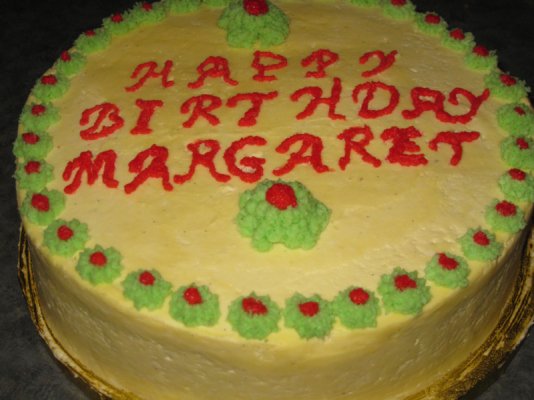I have been making cakes for several years now. I keep practicing, refining my techniques, but I just feel like I'm banging my head against a wall. No matter how hard I try, I can never make a professional cake. Every cake I make has that "home made" look to it that I hate.
Take the latest cake I made. Here's a photo. I made it for a colleague who asked me to make it for his wife's birthday. In the end it looks like a total amateur job. It's bumpy, rough, and messy. You can see a million flaws in the photo. What's worse is he's insisting on paying me $50 for the thing. It cost me way more than that for the ingredients, but I don't want to charge him. For $25 he could have bought a professional cake that looked 100 times better.
What am I doing wrong? I stand there with my icing spatula and heat it up and smooth it for ages trying to smooth out every wrinkle. I sit there and try to pipe everything carefully, but in the end it always looks rough. I'm just really frustrated. It doesn't have to be elaborate... I just want to be able to make cakes that I wouldn't be embarrassed to sell.
How do you make the leap from producing rough "home made" products that wow only friends and family to producing "professional" products that would be at home in a gourmet bakery, or for that matter, even in the counter of the local supermarket?

Take the latest cake I made. Here's a photo. I made it for a colleague who asked me to make it for his wife's birthday. In the end it looks like a total amateur job. It's bumpy, rough, and messy. You can see a million flaws in the photo. What's worse is he's insisting on paying me $50 for the thing. It cost me way more than that for the ingredients, but I don't want to charge him. For $25 he could have bought a professional cake that looked 100 times better.
What am I doing wrong? I stand there with my icing spatula and heat it up and smooth it for ages trying to smooth out every wrinkle. I sit there and try to pipe everything carefully, but in the end it always looks rough. I'm just really frustrated. It doesn't have to be elaborate... I just want to be able to make cakes that I wouldn't be embarrassed to sell.
How do you make the leap from producing rough "home made" products that wow only friends and family to producing "professional" products that would be at home in a gourmet bakery, or for that matter, even in the counter of the local supermarket?

